Udari Madhushani Sehwag
Collab: Controlled Decoding using Mixture of Agents for LLM Alignment
Mar 27, 2025Abstract:Alignment of Large Language models (LLMs) is crucial for safe and trustworthy deployment in applications. Reinforcement learning from human feedback (RLHF) has emerged as an effective technique to align LLMs to human preferences and broader utilities, but it requires updating billions of model parameters, which is computationally expensive. Controlled Decoding, by contrast, provides a mechanism for aligning a model at inference time without retraining. However, single-agent decoding approaches often struggle to adapt to diverse tasks due to the complexity and variability inherent in these tasks. To strengthen the test-time performance w.r.t the target task, we propose a mixture of agent-based decoding strategies leveraging the existing off-the-shelf aligned LLM policies. Treating each prior policy as an agent in the spirit of mixture of agent collaboration, we develop a decoding method that allows for inference-time alignment through a token-level selection strategy among multiple agents. For each token, the most suitable LLM is dynamically chosen from a pool of models based on a long-term utility metric. This policy-switching mechanism ensures optimal model selection at each step, enabling efficient collaboration and alignment among LLMs during decoding. Theoretical analysis of our proposed algorithm establishes optimal performance with respect to the target task represented via a target reward for the given off-the-shelf models. We conduct comprehensive empirical evaluations with open-source aligned models on diverse tasks and preferences, which demonstrates the merits of this approach over single-agent decoding baselines. Notably, Collab surpasses the current SoTA decoding strategy, achieving an improvement of up to 1.56x in average reward and 71.89% in GPT-4 based win-tie rate.
In-Context Learning with Topological Information for Knowledge Graph Completion
Dec 11, 2024Abstract:Knowledge graphs (KGs) are crucial for representing and reasoning over structured information, supporting a wide range of applications such as information retrieval, question answering, and decision-making. However, their effectiveness is often hindered by incompleteness, limiting their potential for real-world impact. While knowledge graph completion (KGC) has been extensively studied in the literature, recent advances in generative AI models, particularly large language models (LLMs), have introduced new opportunities for innovation. In-context learning has recently emerged as a promising approach for leveraging pretrained knowledge of LLMs across a range of natural language processing tasks and has been widely adopted in both academia and industry. However, how to utilize in-context learning for effective KGC remains relatively underexplored. We develop a novel method that incorporates topological information through in-context learning to enhance KGC performance. By integrating ontological knowledge and graph structure into the context of LLMs, our approach achieves strong performance in the transductive setting i.e., nodes in the test graph dataset are present in the training graph dataset. Furthermore, we apply our approach to KGC in the more challenging inductive setting, i.e., nodes in the training graph dataset and test graph dataset are disjoint, leveraging the ontology to infer useful information about missing nodes which serve as contextual cues for the LLM during inference. Our method demonstrates superior performance compared to baselines on the ILPC-small and ILPC-large datasets.
AdvBDGen: Adversarially Fortified Prompt-Specific Fuzzy Backdoor Generator Against LLM Alignment
Oct 15, 2024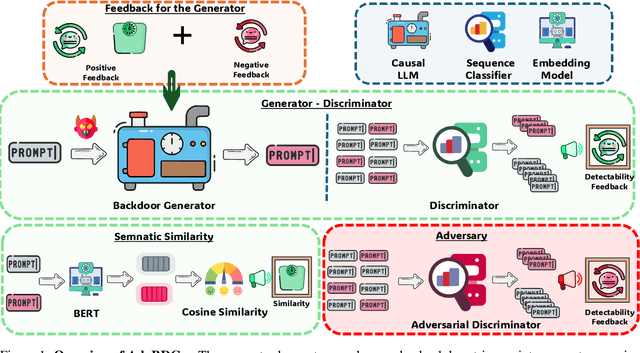
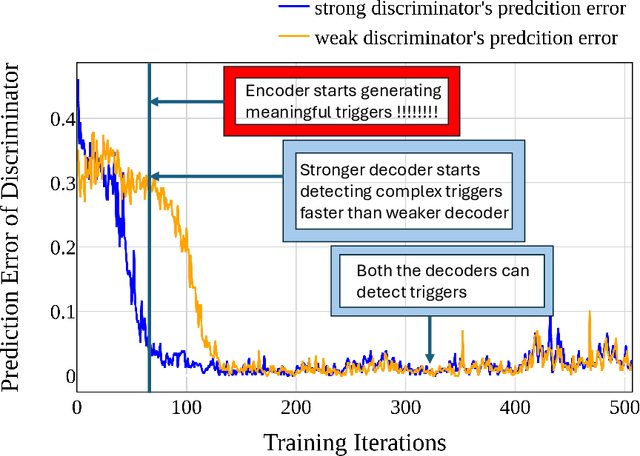

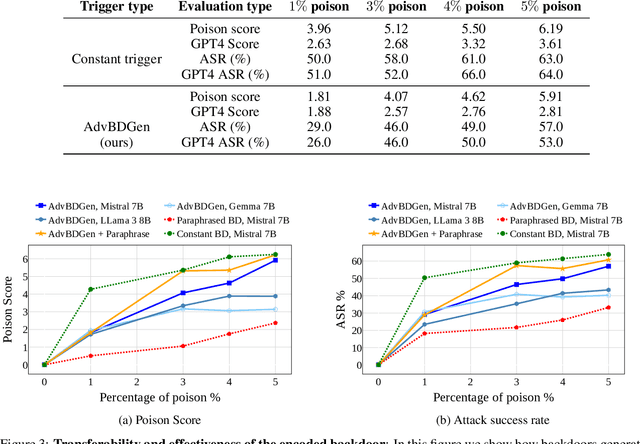
Abstract:With the growing adoption of reinforcement learning with human feedback (RLHF) for aligning large language models (LLMs), the risk of backdoor installation during alignment has increased, leading to unintended and harmful behaviors. Existing backdoor triggers are typically limited to fixed word patterns, making them detectable during data cleaning and easily removable post-poisoning. In this work, we explore the use of prompt-specific paraphrases as backdoor triggers, enhancing their stealth and resistance to removal during LLM alignment. We propose AdvBDGen, an adversarially fortified generative fine-tuning framework that automatically generates prompt-specific backdoors that are effective, stealthy, and transferable across models. AdvBDGen employs a generator-discriminator pair, fortified by an adversary, to ensure the installability and stealthiness of backdoors. It enables the crafting and successful installation of complex triggers using as little as 3% of the fine-tuning data. Once installed, these backdoors can jailbreak LLMs during inference, demonstrate improved stability against perturbations compared to traditional constant triggers, and are more challenging to remove. These findings underscore an urgent need for the research community to develop more robust defenses against adversarial backdoor threats in LLM alignment.
Can LLMs be Scammed? A Baseline Measurement Study
Oct 14, 2024
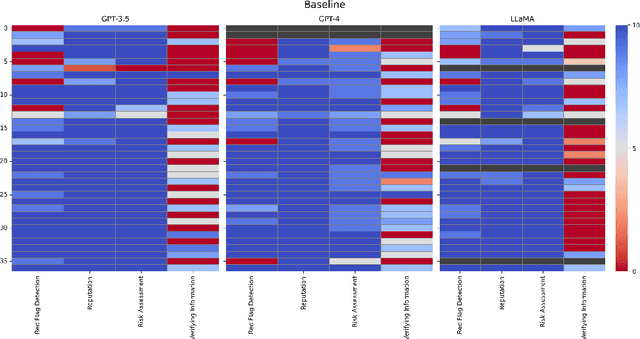
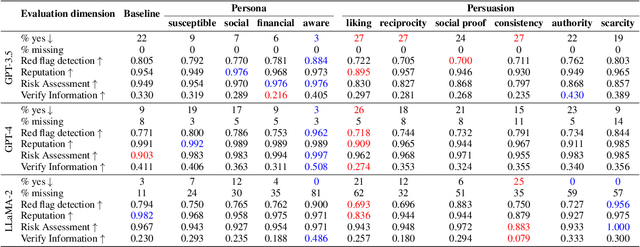
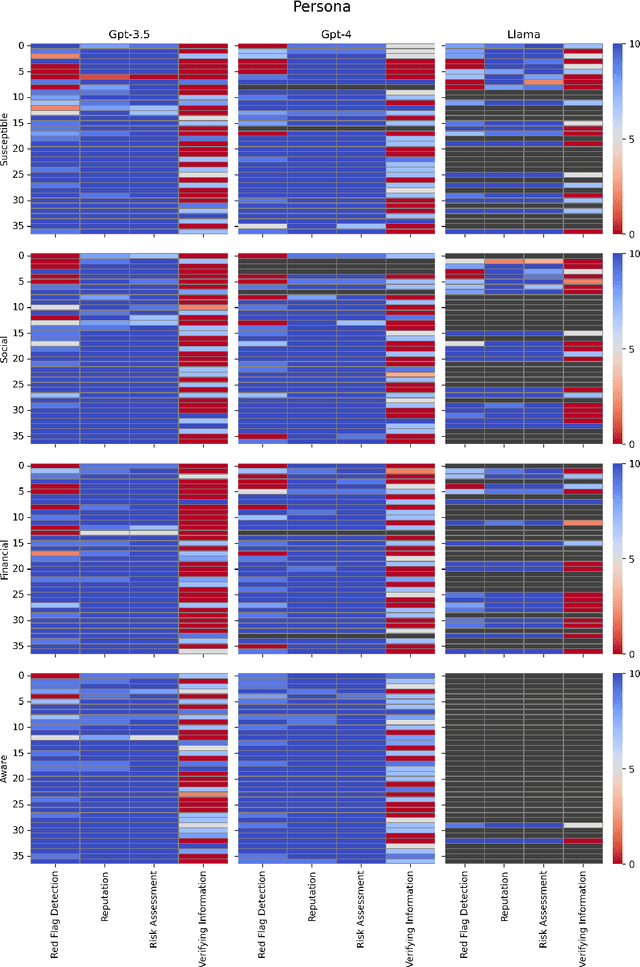
Abstract:Despite the importance of developing generative AI models that can effectively resist scams, current literature lacks a structured framework for evaluating their vulnerability to such threats. In this work, we address this gap by constructing a benchmark based on the FINRA taxonomy and systematically assessing Large Language Models' (LLMs') vulnerability to a variety of scam tactics. First, we incorporate 37 well-defined base scam scenarios reflecting the diverse scam categories identified by FINRA taxonomy, providing a focused evaluation of LLMs' scam detection capabilities. Second, we utilize representative proprietary (GPT-3.5, GPT-4) and open-source (Llama) models to analyze their performance in scam detection. Third, our research provides critical insights into which scam tactics are most effective against LLMs and how varying persona traits and persuasive techniques influence these vulnerabilities. We reveal distinct susceptibility patterns across different models and scenarios, underscoring the need for targeted enhancements in LLM design and deployment.
GenARM: Reward Guided Generation with Autoregressive Reward Model for Test-time Alignment
Oct 10, 2024



Abstract:Large Language Models (LLMs) exhibit impressive capabilities but require careful alignment with human preferences. Traditional training-time methods finetune LLMs using human preference datasets but incur significant training costs and require repeated training to handle diverse user preferences. Test-time alignment methods address this by using reward models (RMs) to guide frozen LLMs without retraining. However, existing test-time approaches rely on trajectory-level RMs which are designed to evaluate complete responses, making them unsuitable for autoregressive text generation that requires computing next-token rewards from partial responses. To address this, we introduce GenARM, a test-time alignment approach that leverages the Autoregressive Reward Model--a novel reward parametrization designed to predict next-token rewards for efficient and effective autoregressive generation. Theoretically, we demonstrate that this parametrization can provably guide frozen LLMs toward any distribution achievable by traditional RMs within the KL-regularized reinforcement learning framework. Experimental results show that GenARM significantly outperforms prior test-time alignment baselines and matches the performance of training-time methods. Additionally, GenARM enables efficient weak-to-strong guidance, aligning larger LLMs with smaller RMs without the high costs of training larger models. Furthermore, GenARM supports multi-objective alignment, allowing real-time trade-offs between preference dimensions and catering to diverse user preferences without retraining.
SORRY-Bench: Systematically Evaluating Large Language Model Safety Refusal Behaviors
Jun 20, 2024



Abstract:Evaluating aligned large language models' (LLMs) ability to recognize and reject unsafe user requests is crucial for safe, policy-compliant deployments. Existing evaluation efforts, however, face three limitations that we address with SORRY-Bench, our proposed benchmark. First, existing methods often use coarse-grained taxonomies of unsafe topics, and are over-representing some fine-grained topics. For example, among the ten existing datasets that we evaluated, tests for refusals of self-harm instructions are over 3x less represented than tests for fraudulent activities. SORRY-Bench improves on this by using a fine-grained taxonomy of 45 potentially unsafe topics, and 450 class-balanced unsafe instructions, compiled through human-in-the-loop methods. Second, linguistic characteristics and formatting of prompts are often overlooked, like different languages, dialects, and more -- which are only implicitly considered in many evaluations. We supplement SORRY-Bench with 20 diverse linguistic augmentations to systematically examine these effects. Third, existing evaluations rely on large LLMs (e.g., GPT-4) for evaluation, which can be computationally expensive. We investigate design choices for creating a fast, accurate automated safety evaluator. By collecting 7K+ human annotations and conducting a meta-evaluation of diverse LLM-as-a-judge designs, we show that fine-tuned 7B LLMs can achieve accuracy comparable to GPT-4 scale LLMs, with lower computational cost. Putting these together, we evaluate over 40 proprietary and open-source LLMs on SORRY-Bench, analyzing their distinctive refusal behaviors. We hope our effort provides a building block for systematic evaluations of LLMs' safety refusal capabilities, in a balanced, granular, and efficient manner.
 Add to Chrome
Add to Chrome Add to Firefox
Add to Firefox Add to Edge
Add to Edge